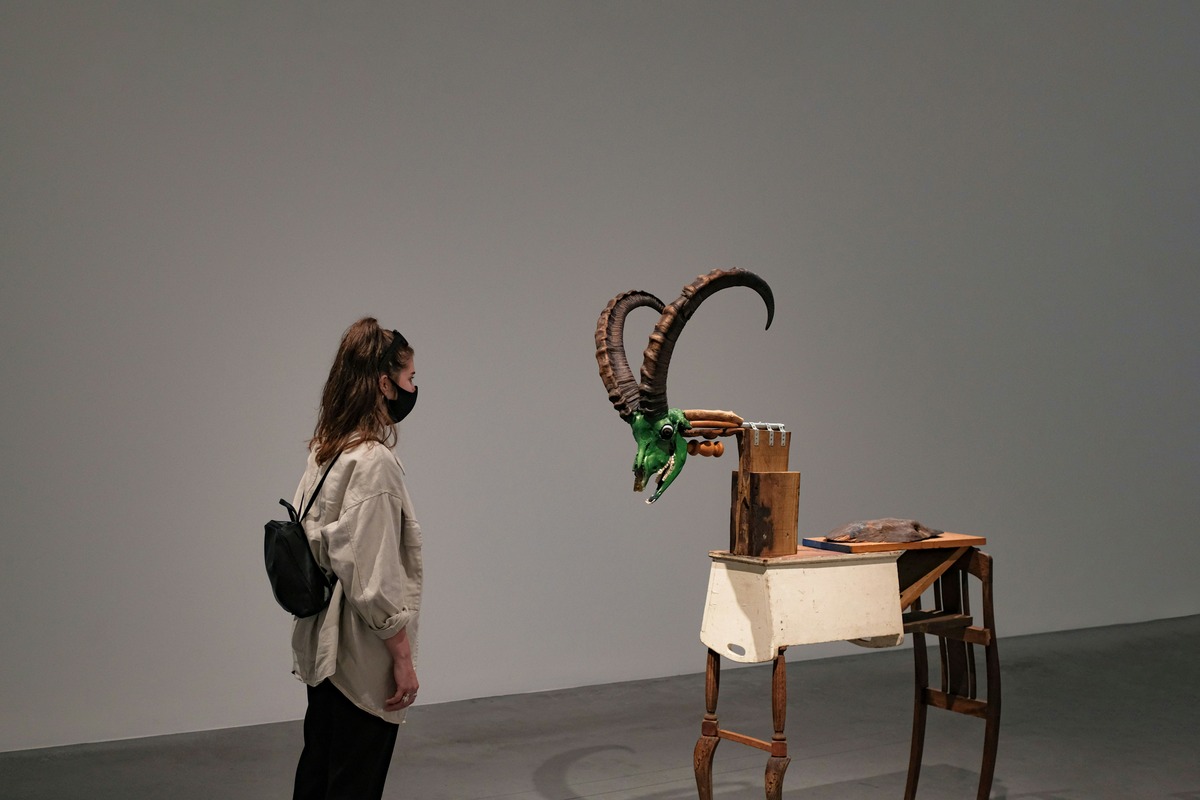Home>Language and Grammar>Unveiling The Surprising Origin And True Meaning Of “Eye Of The Tiger”


Language and Grammar
Unveiling The Surprising Origin And True Meaning Of “Eye Of The Tiger”
Published: February 12, 2024
Discover the unexpected history and authentic significance of "Eye of the Tiger" in relation to language and grammar. Uncover the fascinating origins and true linguistic context.
(Many of the links in this article redirect to a specific reviewed product. Your purchase of these products through affiliate links helps to generate commission for Noodls.com, at no extra cost. Learn more)
Table of Contents
Introduction
The phrase "Eye of the Tiger" has permeated popular culture, evoking images of resilience, determination, and unwavering focus. It's a phrase that resonates deeply with many, conjuring up feelings of strength and tenacity. But have you ever wondered about the origin and true meaning behind this powerful expression? In this article, we will embark on a fascinating journey to unravel the surprising origins and delve into the profound significance of "Eye of the Tiger." From its inception to its enduring impact on modern society, we will explore the multifaceted layers of this evocative phrase, shedding light on its cultural significance and timeless relevance. Join us as we uncover the captivating story behind "Eye of the Tiger" and gain a deeper understanding of its profound implications in our lives.
Read more: Unveiling The True Meaning Of ‘Say Less’
The Origin of "Eye of the Tiger"
The origin of the phrase "Eye of the Tiger" can be traced back to the world of music and cinema. It gained widespread recognition as the title of the iconic song by the rock band Survivor, which was prominently featured in the blockbuster film "Rocky III." Composed by Frankie Sullivan and Jim Peterik, "Eye of the Tiger" became synonymous with the indomitable spirit of the film's protagonist, Rocky Balboa, portrayed by Sylvester Stallone.
The song was specifically written at Stallone's request to serve as the theme for "Rocky III," infusing the movie with an anthemic and motivational soundtrack that perfectly encapsulated the protagonist's journey of resilience and triumph. Released in 1982, "Eye of the Tiger" quickly soared to the top of the music charts, capturing the hearts of audiences worldwide with its rousing melody and empowering lyrics.
The title itself, "Eye of the Tiger," was inspired by a phrase used by Stallone to describe the essence of the film's narrative. In an interview, Jim Peterik revealed that Stallone conveyed the idea of the "eye of the tiger" as a metaphor for the unwavering focus and determination needed to confront life's challenges head-on. This powerful imagery resonated deeply with the songwriters, leading to the creation of a timeless anthem that continues to inspire and uplift listeners across generations.
Beyond its association with "Rocky III," the phrase "Eye of the Tiger" has transcended its musical origins to become a symbol of resilience and fortitude in the face of adversity. Its evocative nature has led to its widespread adoption in various contexts, from sports arenas to motivational speeches, where it serves as a rallying cry for perseverance and unwavering determination.
The enduring legacy of "Eye of the Tiger" as a cultural phenomenon is a testament to its profound impact on popular culture. Its origin as a musical and cinematic expression has evolved into a universal symbol of strength and tenacity, embodying the human spirit's unyielding resolve to overcome obstacles and emerge victorious.
In essence, the origin of "Eye of the Tiger" is deeply intertwined with the creative synergy between music, film, and the human experience, culminating in a timeless emblem of courage and resilience that continues to resonate with audiences worldwide.
The True Meaning of "Eye of the Tiger"
At its core, the true meaning of "Eye of the Tiger" transcends its literal interpretation and delves into the realm of human determination, perseverance, and unwavering focus. The phrase encapsulates the essence of resilience in the face of adversity, embodying the spirit of rising above challenges with unyielding determination and courage.
"Eye of the Tiger" symbolizes the unwavering focus and unrelenting drive to confront obstacles head-on, refusing to succumb to defeat. It represents the innate strength within individuals to navigate through life's trials with a fierce and unyielding resolve, much like the predatory instinct of a tiger stalking its prey with laser-sharp concentration.
The true meaning of "Eye of the Tiger" extends beyond mere determination; it embodies the relentless pursuit of one's goals, fueled by an unshakeable belief in one's abilities. It serves as a powerful reminder that success often hinges on the ability to maintain a steadfast gaze on the desired outcome, regardless of the challenges encountered along the way.
Furthermore, "Eye of the Tiger" conveys the notion of mental fortitude and unwavering commitment to achieving one's aspirations, even in the face of daunting odds. It inspires individuals to harness their inner strength, channeling their resilience and tenacity to overcome obstacles and emerge victorious, much like the unwavering gaze of a tiger fixated on its target.
The phrase resonates deeply with individuals from all walks of life, serving as a universal symbol of empowerment and fortitude. Whether in the realm of sports, academics, professional pursuits, or personal challenges, "Eye of the Tiger" embodies the relentless pursuit of excellence and the refusal to be deterred by setbacks.
In essence, the true meaning of "Eye of the Tiger" encapsulates the indomitable human spirit, igniting a fire within individuals to persevere, overcome, and triumph in the face of adversity. It stands as a testament to the unwavering resolve that propels individuals to navigate life's obstacles with courage, resilience, and an unyielding focus on achieving their aspirations.
Cultural Impact of "Eye of the Tiger"
The cultural impact of "Eye of the Tiger" extends far beyond its origins in music and film, permeating various facets of popular culture and leaving an indelible mark on society. Since its debut in the early 1980s, the phrase has become synonymous with resilience, determination, and the unwavering pursuit of success, earning its place as a timeless emblem of human fortitude.
In the realm of sports, "Eye of the Tiger" has emerged as a ubiquitous anthem, igniting the spirits of athletes and fans alike. Its empowering lyrics and rousing melody have been embraced as a motivational soundtrack in sporting events, inspiring competitors to summon their inner strength and push beyond their limits. The phrase has become a rallying cry for teams and individuals, symbolizing the relentless pursuit of victory and the refusal to succumb to adversity.
Moreover, "Eye of the Tiger" has transcended its musical origins to permeate the motivational landscape, finding resonance in speeches, self-help literature, and personal development seminars. Its evocative imagery of unwavering focus and unyielding determination has made it a go-to reference for individuals seeking to overcome obstacles and achieve their aspirations. The phrase serves as a powerful reminder of the human capacity to persevere in the face of adversity, resonating with individuals striving for personal and professional growth.
In the realm of popular culture, "Eye of the Tiger" has been immortalized in various forms, from parodies in comedic sketches to references in television shows and films. Its enduring presence in the cultural zeitgeist underscores its status as a symbol of resilience and tenacity, perpetuating its relevance across generations.
Furthermore, the phrase has permeated the corporate world, where it is often invoked to encapsulate the ethos of determination and unwavering focus in achieving organizational goals. "Eye of the Tiger" has become a metaphor for resilience in the face of challenges, inspiring teams and leaders to confront obstacles with courage and perseverance.
In essence, the cultural impact of "Eye of the Tiger" is a testament to its universal resonance and enduring relevance. Its pervasive influence across sports, motivational arenas, popular culture, and the corporate landscape underscores its status as a timeless emblem of human resilience and unwavering determination. As the phrase continues to inspire and uplift individuals across diverse spheres, its cultural impact remains an enduring testament to the indomitable human spirit.
Conclusion
In conclusion, the phrase "Eye of the Tiger" transcends its origins as a song title and embodies a profound symbol of human resilience, determination, and unwavering focus. From its inception as the anthemic soundtrack of "Rocky III" to its enduring impact on popular culture, "Eye of the Tiger" has evolved into a universal emblem of fortitude, inspiring individuals across diverse spheres of life.
The journey to unravel the surprising origins and delve into the true meaning of "Eye of the Tiger" has unveiled a narrative rich in creativity, perseverance, and the indomitable human spirit. Its association with the iconic film franchise "Rocky" and its meteoric rise to the top of the music charts in the 1980s solidified its status as a cultural phenomenon, resonating with audiences worldwide.
The true meaning of "Eye of the Tiger" extends beyond its literal interpretation, encapsulating the essence of resilience in the face of adversity. It symbolizes the unwavering focus and unrelenting drive to confront obstacles with courage and determination, serving as a powerful reminder of the human capacity to persevere and triumph in the face of challenges.
Furthermore, the cultural impact of "Eye of the Tiger" has been far-reaching, permeating the realms of sports, motivational arenas, popular culture, and the corporate landscape. Its pervasive influence as a symbol of unwavering determination underscores its enduring relevance, inspiring individuals to summon their inner strength and push beyond their limits.
As we reflect on the captivating story behind "Eye of the Tiger," it becomes evident that its significance goes beyond mere words or melodies. It represents the resilience and tenacity that define the human experience, resonating with individuals striving for personal and professional growth, and serving as a rallying cry for teams and leaders confronting obstacles with courage and perseverance.
In essence, "Eye of the Tiger" stands as a timeless emblem of human resilience, igniting a fire within individuals to persevere, overcome, and triumph in the face of adversity. Its enduring legacy as a cultural phenomenon is a testament to the unwavering resolve that propels individuals to navigate life's obstacles with courage, resilience, and an unyielding focus on achieving their aspirations.















